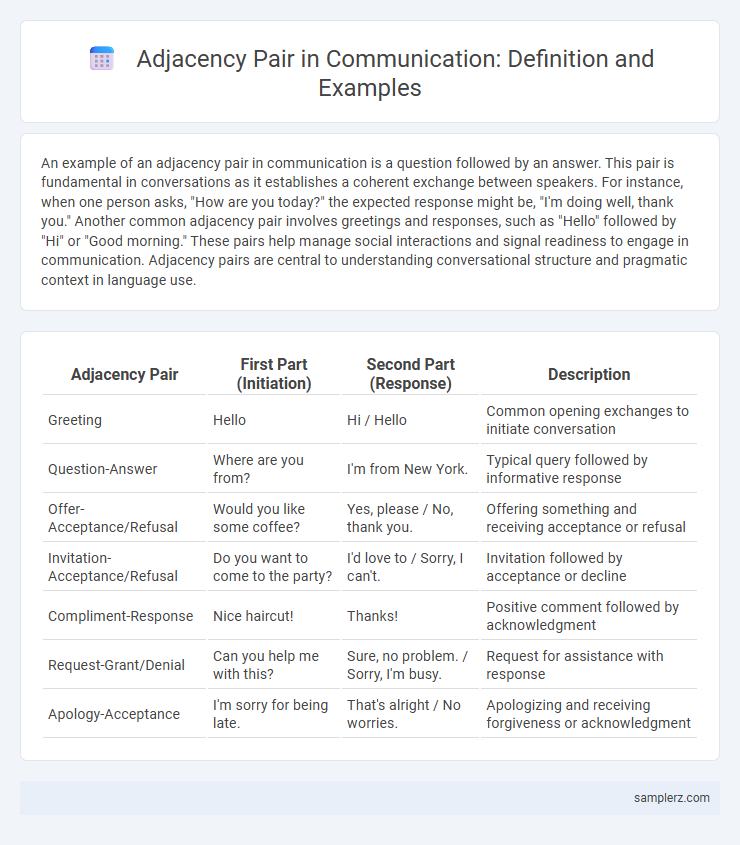An example of an adjacency pair in communication is a question followed by an answer. This pair is fundamental in conversations as it establishes a coherent exchange between speakers. For instance, when one person asks, "How are you today?" the expected response might be, "I'm doing well, thank you." Another common adjacency pair involves greetings and responses, such as "Hello" followed by "Hi" or "Good morning." These pairs help manage social interactions and signal readiness to engage in communication. Adjacency pairs are central to understanding conversational structure and pragmatic context in language use.
Table of Comparison
| Adjacency Pair | First Part (Initiation) | Second Part (Response) | Description |
|---|---|---|---|
| Greeting | Hello | Hi / Hello | Common opening exchanges to initiate conversation |
| Question-Answer | Where are you from? | I'm from New York. | Typical query followed by informative response |
| Offer-Acceptance/Refusal | Would you like some coffee? | Yes, please / No, thank you. | Offering something and receiving acceptance or refusal |
| Invitation-Acceptance/Refusal | Do you want to come to the party? | I'd love to / Sorry, I can't. | Invitation followed by acceptance or decline |
| Compliment-Response | Nice haircut! | Thanks! | Positive comment followed by acknowledgment |
| Request-Grant/Denial | Can you help me with this? | Sure, no problem. / Sorry, I'm busy. | Request for assistance with response |
| Apology-Acceptance | I'm sorry for being late. | That's alright / No worries. | Apologizing and receiving forgiveness or acknowledgment |
Introduction to Adjacency Pairs in Communication
Adjacency pairs in communication consist of paired utterances where the first prompts an expected response, such as a greeting followed by a return greeting. Common examples include question-answer, offer-acceptance, or complaint-apology sequences, demonstrating structured interaction patterns. These pairs facilitate turn-taking and coherence in conversations, forming the foundation of effective communication.
Definition and Importance of Adjacency Pairs
Adjacency pairs are fundamental units of conversation consisting of two related utterances by different speakers, such as questions followed by answers or greetings paired with responses. These pairs establish the structure of dialogue, enabling smooth and coherent interaction by setting expectations for appropriate responses. Understanding adjacency pairs is crucial for effective communication as they facilitate turn-taking, clarify intent, and enhance mutual understanding in social exchanges.
Greeting and Response Examples
In communication, a common example of an adjacency pair is the greeting and response exchange, where one speaker says "Hello," and the other replies with "Hi" or "Hello." This interaction establishes social connection and signals willingness to engage in conversation. Variations in greetings, such as "Good morning" followed by "Good morning," reflect politeness norms and cultural contexts within dialogue.
Question and Answer Adjacency Pairs
Question and answer adjacency pairs are fundamental structures in communication where one speaker's question prompts a related response from another. Classic examples include "Where are you going?" followed by "I'm going to the store," or "Did you finish the report?" answered with "Yes, I submitted it this morning." These pairs facilitate smooth conversational flow by establishing clear, predictable interaction patterns essential in both everyday communication and formal discourse.
Invitation and Acceptance/Refusal Pairs
Invitation and Acceptance/Refusal pairs exemplify adjacency pairs in communication, where the initial utterance invites participation and the response confirms or declines the offer. For instance, an invitation such as "Would you like to join the meeting tomorrow?" is typically followed by acceptance like "Yes, I'll be there" or refusal such as "Sorry, I'm unavailable." These pairs demonstrate turn-taking structures essential in conversational coherence and social interaction management.
Offer and Acceptance/Decline Examples
In communication, an example of an adjacency pair involving offer and acceptance is seen when one person says, "Would you like some coffee?" and the other responds, "Yes, please." Conversely, an offer and decline pair occurs when the same offer is met with a response like, "No, thank you." These exchanges illustrate turn-taking and the cooperative nature of conversational structure.
Request and Compliance/Refusal Scenarios
In communication, a common example of an adjacency pair involves a request followed by compliance or refusal, such as when a person asks, "Can you send me the report by this afternoon?" and the recipient responds with "Yes, I'll have it ready by 4 PM" or "I'm sorry, I won't be able to meet that deadline." This exchange highlights the essential turn-taking structure that shapes effective interaction and clarity in conversational requests and responses. Understanding these patterns is crucial for analyzing dialogue dynamics and improving interpersonal communication skills.
Apology and Acknowledgment Pairs
An example of an adjacency pair in communication is the exchange between apology and acknowledgment, where one party offers an apology such as "I'm sorry for missing the meeting," and the other responds with acknowledgment like "I appreciate your apology." This structure helps maintain social harmony by recognizing responsibility and fostering mutual understanding. Effective use of apology and acknowledgment pairs enhances conflict resolution and relationship repair in interpersonal communication.
Compliment and Response Examples
A common adjacency pair in communication is a compliment followed by a response, such as "You did an excellent job on the presentation" and "Thank you, I worked hard on it." Another example includes "I love your new haircut" paired with "I'm glad you like it, I just got it done yesterday." These exchanges help facilitate rapport and positive interaction by acknowledging compliments and reciprocating appreciation.
Closing and Parting Adjacency Pairs
Closing and parting adjacency pairs in communication often include phrases like "Goodbye" followed by "See you later" or "Have a nice day" paired with "Thank you, you too." These pairs signal the end of an interaction and help create a smooth transition from conversation to departure. Effective use of closing adjacency pairs enhances conversational coherence and social rapport.

example of adjacency pair in communication Infographic
 samplerz.com
samplerz.com